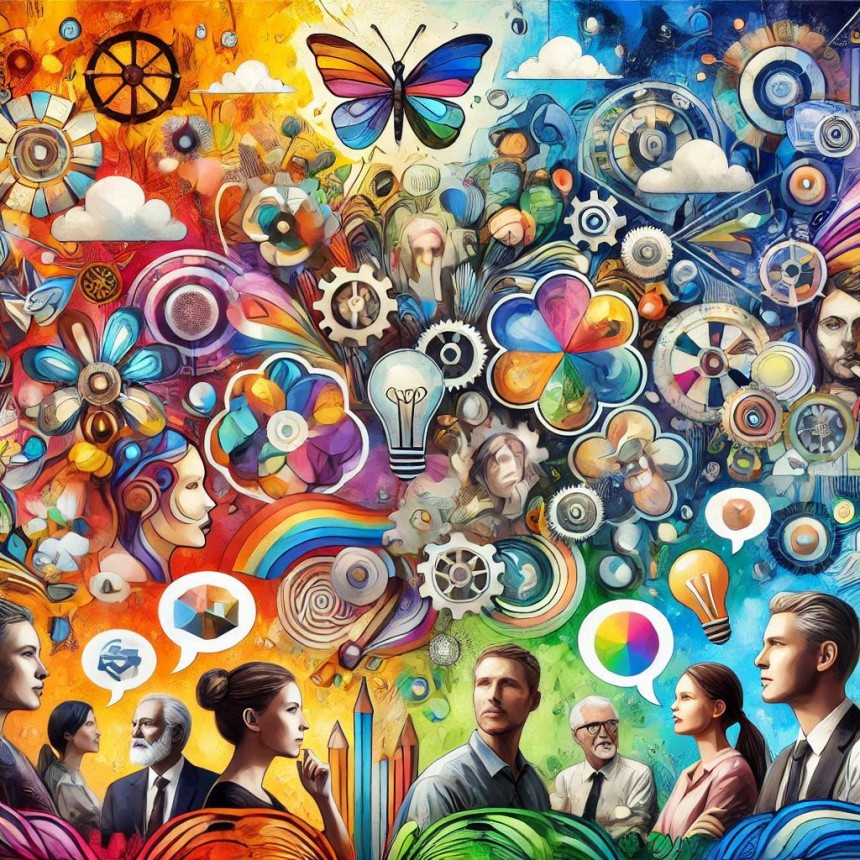Opinions and Perceptions
The Art of Viewing the World Differently

Perspectives and opinions are closely related yet highly distinct.
Many people confuse these two terms. When one person says, “That’s my opinion,” they might mean, “That’s my perspective.” Without clear distinctions, we often interpret one as a synonym for the other… Since perspectives and opinions are subjective and based on personal experiences, they are frequently mixed up.
"Perspective and opinions shape our understanding of the world and influence how we interact with others." - Unknown
Understanding Perspectives & Opinions
Take a look at the following example: A number ‘6’ is drawn on the ground, and one person is standing in front of it while the second person is on the opposite side. One views it as a ‘6’ while the other views it as ‘9’… What do you understand from it?
Perspective means a way of thinking and understanding about something. It is also a person’s point of view, which is based on experiences, cultural backgrounds, and the context in which one interacts with others.
On the other hand, opinions refer to a view, judgment, or appraisal formed in the mind regarding a particular matter. It is a belief; an attitude about something having no supporting statements or facts.
In the same number example, their opinions are different. One says it is a ‘6’ while the other says that it clearly shows a ‘9’. But when their positions are changed so do their opinions. The one saying six will say ‘9’ and vice versa.
Perspective is the Point of View of an Individual
Perspective can shape individuals ‘truth’ and realities. For example in countries like India, Pakistan, China, and Japan; it is considered rude to call someone older than you by their first name, instead, they should be referred to by their title like “Mr.”, “Mrs.”, “Uncle”, “Aunt”, or specific familial or professional designations like, “Elder brother”, “Teacher” or “Sir/Madam”. This reflects the deep-rooted cultural emphasis on respect for elders and authoritative figures.
In contrast, in many Western countries, addressing someone older or younger by their first name is a gesture of equality and friendliness.
Both different cultures shape different perspectives on respect, hierarchy and communication. Neither approach is wrong or right — simply reflects the truths people live by according to their up bringing.
“When you change the way you look at things, the things you look at begin to change.” — Dr. Wayne Dyer
Opinion is the Result of that View
Opinions reflect an individual’s values and beliefs… In a debate one team stands on the statement that AI growth is destructive for our coming generations, fearing the dawn of ‘Robotic Wars’ (Opinion 1). The opponent team states that through AI we can achieve peace and tranquility in our lives making Earth’s and its inhabitant’s future better and carefree (Opinion 2).
Values and beliefs behind Opinion 1 are:
- A belief that AI might become super intelligent.
- Fear they might take over.
- A value system that prioritizes male labour over total robotic labour.
Values and beliefs behind Opinion 2 are:
- A belief that AI can make the world a better place.
- Humans and AI can work hand in hand.
- A value system that aims to create a peaceful environment for growth and development.
The different opinions underline the values and beliefs of both sides, even when they are addressing the same issue. By understanding their opinions we can understand their priorities and the essential truths accordingly.
Opinions are like mirrors. They reflect the thinker’s inner beliefs, not the absolute truth.
Dynamic Nature
Just like mentioned before, perspectives are based on facts and knowledge, so as we gain more knowledge our perspective can also change. Suppose someone in your class/workspace states that climate change and its effects are a hoax. This perspective might be based on the lack of knowledge of scientific studies or misinformation. You try to change their point of view (perspective) by making them understand but they remain steadfast in their words and say all is fake. But as they gain more understanding — such as reading research papers, discussing with experts and attending seminars, they might understand the gravity of the situation resulting in them changing their perspective on the problem.
This shows that perspectives, while based on knowledge and facts, are not stationary. They can shift as new information, research, and discoveries are introduced enabling individuals to see the world from a more informed and significant viewpoint
Opinions on the other hand can change quite quickly as they are influenced by immediate circumstances, feelings and even desires. Your friend is a huge fan of K-dramas while you crave Classic American Rom-Coms. Both of you dislike the other’s choice, dismissing them as ‘boring’ or ‘overrated’.
One day you decided to switch it up to step out of your comfort zone. Your friend watches your favorite Rom-Coms and you watch their favorite K-drama. After watching it, both of your opinions changed regarding the others’ 'tastes'. Your opinion on K-dramas changes from ‘overrated’ to ‘captivating’ and ‘emotional’ and your friend’s opinion shifts from ‘boring’ to ‘humorous’ and ‘heartfelt’.
This change demonstrates how opinions are tied to emotions and situational experiences and can adapt quickly when new contexts are introduced.
Benefits from Understanding
1. Promoting Empathy and Tolerance
Realizing that perspectives are formed by experiences and cultural backgrounds helps us to understand one’s choices and appreciate one’s diversity of thoughts. We empathize with their situation and respect their side of the story.
2. Bridging Social & Cultural Divides
When we become clear on the difference between perspectives and opinions, it becomes beneficial for many societies with diverse cultures allowing them to help one another
3. Supporting Conflict Resolution
Many conflicts take place mainly due to misunderstood perspectives. When a person says he hates burgers, that is his opinion. He might not like them because they are unhealthy or simply because their flavour doesn’t suit his taste buds.
4. Enhancing Critical Thinking
Teaching students the difference fosters critical thinking and enables them to evaluate issues comprehensively rather than creating results based on opinions and feelings lacking information. Furthermore, it allows them to build constructive conversations and are more likely to deliver their thoughts.
The diversity of perspectives and opinions enriches humanity’s collective understanding, fosters creativity, and enhances our shared journey of growth and progress.
By embracing our differences, we cultivate a more emphatic, inclusive, and dynamic world.
Your opinion is your opinion, your perception is your perception — do not confuse them with ‘facts’ or ‘truth.’
How to Unblur Images Online Instantly – The Best Tools & Tips
Unblur your images instantly with our free AI unblur image online app. Improve image quali...



